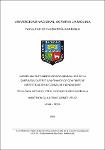Mostrar el registro sencillo del ítem
Modelamiento hidrológico e hidráulico de la quebrada caserío San Francisco con fines de identificación de zonas de inundación
| dc.contributor.advisor | Sánchez Delgado, Miguel Ángel | |
| dc.contributor.author | Gómez Veliz, Anderson Guillermo | |
| dc.date.accessioned | 2023-05-30T20:45:53Z | |
| dc.date.available | 2023-05-30T20:45:53Z | |
| dc.date.issued | 2022 | |
| dc.identifier.uri | https://hdl.handle.net/20.500.12996/5834 | |
| dc.description | Universidad Nacional Agraria La Molina. Facultad de Ingeniería Agrícola. Departamento Académico de Recursos Hídricos | es_PE |
| dc.description.abstract | En la presente investigación se planteó una simulación de la avenida máxima con periodos de retorno de 140, 200 y 500 años, utilizando como datos de entrada a los caudales máximos que serán obtenidos a partir de las precipitaciones máximas de 24 horas entre 1981 al 2016, recopiladas de las estaciones pluviométricas e hidrométricas de mayor influencia en la quebrada caserío San Francisco y analizadas estadísticamente para alcanzar la consistencia y correcta distribución de frecuencias de dichos datos. Logrando obtener las precipitaciones máximas para cada periodo de retorno establecido y proceder con los cálculos manuales de generación de caudales máximos, los cuales se calibraron, validaron y optimizaron haciendo uso del ajuste de algunos parámetros morfométricos de la quebrada y procedimientos hidrológicos tales como la curva número, el hidrograma unitario del US Soil Conservation Service, y métodos de aforo con el fin de ajustar el caudal simulado con el caudal observado. Obteniéndose los caudales de 75, 80 y 85 m3/s, con los que se procedió a realizar el modelo hidráulico con la herramienta HecGeoRAS, posteriormente exportando la geometría al software Hec-Ras. El resultado de la simulación permitió que se identificaran las zonas inundadas siendo 34 hectáreas en predios registrados y aún mayor sumando las hectáreas de actividad agrícola y ganadera sin registrar. Finalmente, el análisis de riesgo de inundación permitió integrar las variables vectoriales en orden, secuencia lógica y jerárquica por el método de la matriz de Saaty y así conocer los niveles de peligro (32.71% nivel muy alto), vulnerabilidad (49.17% nivel medio) y riesgo de inundación fluvial (47.58% nivel alto) representados en mapas temáticos y estimados en pérdidas probables reflejados en costos monetarios como S/4,001,741.50 (cuatro millones y un mil setecientos cuarenta y uno con 50/100 soles). | es_PE |
| dc.description.abstract | In the present investigation a simulation of the maximum flood with return periods of 140, 200 and 500 years was proposed, using as input data the maximum flows that will be obtained from the maximum rainfall of 24 hours between 1981 and 2016, collected from the pluviometric and hydrometric stations of greater influence in the San Francisco stream and statistically analyzed to achieve consistency and correct frequency distribution of such data. The maximum rainfall for each established return period was obtained and manual calculations were made to generate maximum flows, which were calibrated, validated and optimised by adjusting some morphometric parameters of the stream and hydrological procedures such as the number curve, the unit hydrograph of the US Soil Conservation Service, and gauging methods in order to adjust the simulated flow with the observed flow. The flow rates of 75, 80 and 85 m3/s were obtained, which were used to make the hydraulic model with the HecGeoRAS tool, subsequently exporting the geometry to the Hec-Ras software. The result of the simulation allowed the flooded areas to be identified, with 34 hectares of registered properties and even more hectares of unregistered agricultural and livestock activity. Finally, the flood risk analysis made it possible to integrate the vector variables in order, logical and hierarchical sequence using the Saaty matrix method and in this way to determine the levels of danger (32.71% very high level), vulnerability (49.17% medium level) and fluvial flood risk (47.58% high level) represented in thematic maps and estimated in probable losses reflected in monetary costs such as S/4,001,741.50 (four million and one thousand seven hundred and forty-one thousand and fifty hundred and fifty soles). | es_PE |
| dc.format | application/pdf | es_PE |
| dc.language.iso | spa | es_PE |
| dc.publisher | Universidad Nacional Agraria La Molina | es_PE |
| dc.rights | info:eu-repo/semantics/openAccess | es_PE |
| dc.rights.uri | https://creativecommons.org/licenses/by-nc/4.0/ | es_PE |
| dc.subject | Control de inundaciones | es_PE |
| dc.subject | Cuencas hidrográficas | |
| dc.subject | Cursos de agua | |
| dc.subject | Erosión hídrica | |
| dc.subject | Evaluación | |
| dc.subject | Hidrodinámica | |
| dc.subject | Máximas avenidas | |
| dc.subject | Modelamiento hidrológico | |
| dc.subject | Modelos de simulación | |
| dc.subject | Perú | |
| dc.subject | Simulación | |
| dc.subject | Valoración de tierras | |
| dc.title | Modelamiento hidrológico e hidráulico de la quebrada caserío San Francisco con fines de identificación de zonas de inundación | es_PE |
| dc.type | info:eu-repo/semantics/bachelorThesis | es_PE |
| thesis.degree.discipline | Ingeniería Agrícola | es_PE |
| thesis.degree.grantor | Universidad Nacional Agraria La Molina. Facultad de Ingeniería Agrícola | es_PE |
| thesis.degree.name | Ingeniero Agrícola | es_PE |
| dc.subject.ocde | https://purl.org/pe-repo/ocde/ford#1.05.11 | |
| renati.author.dni | 76578254 | es_PE |
| dc.publisher.country | PE | es_PE |
| dc.type.version | info:eu-repo/semantics/publishedVersion | es_PE |
| renati.advisor.orcid | https://orcid.org/0000-0003-4441-7871 | es_PE |
| renati.advisor.dni | 08861378 | es_PE |
| renati.type | https://purl.org/pe-repo/renati/type#tesis | es_PE |
| renati.level | https://purl.org/pe-repo/renati/level#tituloProfesional | es_PE |
| renati.discipline | 811096 | es_PE |
| renati.juror | Chávarri Velarde, Eduardo Abraham | |
| renati.juror | Ramos Taipe, Cayo Leonidas | |
| renati.juror | Apaclla Nalvarte, Ricardo |
Ficheros en el ítem
Este ítem aparece en la(s) siguiente(s) colección(ones)
-
IAG-RH Tesis [307]





